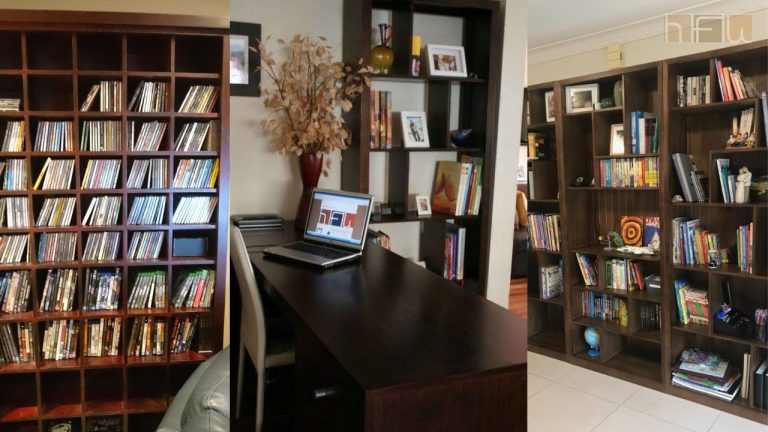In the realm of furniture and interior design, the terms “bookcase” and “bookshelf” are often used interchangeably. However, these two items, while similar, possess distinct characteristics and purposes. This article delves into the subtle differences between bookcases and bookshelves, drawing insights from a Sydney linguist’s perspective.
Historical Background
Understanding the evolution of the terms “bookcase” and “bookshelf” requires a look back into history. The concept of book storage dates back to ancient civilisations, where scrolls and manuscripts were stored in specially designed cases. As the printing press revolutionised book production, the need for proper storage became more pronounced, leading to the development of furniture specifically designed to house books.
Defining a Bookcase
A bookcase is more than just a piece of furniture; it’s a curated display of knowledge, a testament to curiosity, and a sanctuary for the written word. Standing tall, its shelves provide a home for volumes of stories, wisdom, and imagination. Each bookcase tells a unique tale, reflecting the personality and passions of its owner.
At its core, a bookcase is a structure of possibility. It invites exploration, beckoning visitors to wander through its corridors of literature, discovering new worlds and ideas with every turn of a page. Its shelves may hold works of fiction, non-fiction, poetry, and beyond, offering a diverse array of perspectives and insights.
Yet, a bookcase is more than just a repository for books. It’s a symbol of organisation and intellectual curiosity, showcasing the careful arrangement of volumes based on genre, author, or theme. From meticulously alphabetized collections to haphazardly stacked tomes, each bookcase reflects the individuality of its curator.
Moreover, a bookcase is typically a large, often freestanding piece of furniture. It features multiple shelves enclosed within a frame, which may include doors or glass panels. Bookcases are designed not only for storing books but also for protecting them from dust and damage. They often serve as prominent pieces of furniture in living rooms, libraries, and offices, providing both functional and aesthetic value.
In essence, a bookcase is a shrine to the written word, honouring the enduring legacy of literature in our lives. It embodies the timeless pursuit of knowledge and the joy of discovery, inviting all who encounter it to embark on a journey of enlightenment and imagination.
Defining a Bookshelf
A bookshelf is a piece of furniture with horizontal shelves, typically made of wood, metal, or glass, used for storing books and other items. Bookshelves are commonly found in homes, libraries, and offices. They come in various sizes and designs, ranging from small, single-shelf units to large, multi-shelf models that can span an entire wall. Some bookshelves have adjustable shelves, allowing for flexibility in storing items of different heights, while others have fixed shelves. They serve both a practical purpose in organising books and a decorative role in displaying personal collections and home decor.
Understanding the Difference Between Bookcase and Bookshelf
The world of furniture, seemingly interchangeable terms like “bookcase” and “bookshelf” often cause confusion. However, to a linguist, these words carry distinct nuances that reflect their unique roles and designs.
Practical Usage
In practical terms, choosing between a bookcase and a bookshelf depends largely on the user’s needs and the space available. A bookcase, with its enclosed design, is suitable for larger collections of books and offers protection from environmental factors. It can also serve as a statement piece in a room. On the other hand, a bookshelf is perfect for smaller collections and spaces, providing flexibility and ease of access.
Additionally, Beyond Furnishings
While “bookcase” and “bookshelf” are frequently used interchangeably in casual conversation, they denote distinct pieces of furniture with individual designs and functions. Understanding these disparities can aid in selecting the appropriate furnishing for a given space. Linguistically, discerning the subtle nuances between these terms enhances our mastery of language and its pragmatic applications. Whether opting for a bookcase or a bookshelf, each fulfils its unique purpose in storing and showcasing books.
Wooden Furniture Can Last For Hundreds or Even Thousands of Years
Recent Posts
- Enhance Your Space with the Perfect Entertainment Unit Style
- Revamp Your Living Space with Style: Coffee Table Transformation
- Bookcase vs Bookshelf: A Sydney Linguist Explains the Differences
- Craftsmanship at Its Finest: Unveiling Habitat Furniture’s Masterpieces
- Protect Your Timber/Wooden Furniture From Termites
Archives
- June 2024
- May 2024
- April 2024
- July 2023
- February 2022
- December 2021
- October 2021
- July 2021
- May 2021
- March 2021
- January 2021
- December 2020
- October 2020
- December 2018
- November 2018
- September 2018
- August 2018
- July 2018
- April 2018
- March 2018
- November 2017
- October 2017
- June 2017
- May 2017
- April 2017
- March 2017
